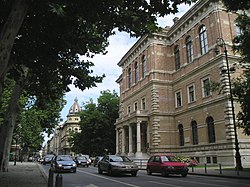Croatian Academy of Sciences and Arts
| Hrvatska Akademija Znanosti i Umjetnosti HAZU |
|
|---|---|

|
|
| founding | 1866 |
| place | Zagreb , Croatia |
| management | Velimir Neidhardt |
| Website | www.hazu.hr |
The Croatian Academy of Sciences and Arts ( Croatian : Hrvatska akademija znanosti i umjetnosti - HAZU ; formerly Jugoslavenska akademija znanosti i umjetnosti 'Yugoslav Academy of Sciences and Arts' - JAZU) is the highest scientific institution in Croatia and is based in the capital Zagreb .
The president of the academy is Zvonko Kusić .
history
The Academy of Sciences goes back to a "Yugoslav Academy" in Zagreb, which was initiated by Josip Juraj Strossmayer in 1848 and founded on March 4, 1866 by Emperor Franz Joseph I. This should serve to promote the culture of all southern Slavs. Although the Serbian Scholarly Society was converted into the Serbian Academy of Sciences and Arts in 1886, both academies worked closely together and both had members from the entire South Slavic-speaking area, the Serbian Academy also from the West and East Slavic.
In the fascist Independent State of Croatia , which existed from 1941 to 1945, it was called the Croatian Academy of Sciences , while in socialist Yugoslavia it operated again under its founding name.
The academy originally had 14 members; there were three departments, and from 1919 four departments. In 1947 a reorganization took place, after which the academy had the following eight departments: 1. Philosophy and social sciences, 2. Mathematics, physics and technical sciences, 3. Natural sciences (including agricultural and forest sciences), 4. Medicine (including veterinary medicine) , 5. Philology, 6. Contemporary literature, 7. Arts, 8. Music. After the Second World War, several institutes were founded, such as B. the Institute of the Yugoslav Academy in Zadar and the Institute of History of the Yugoslav Academy of Sciences and Arts in Dubrovnik .
It has had its current name since Croatia's independence in 1991. Today the importance and position of the academy for the preservation of Croatian culture and science is enshrined in the constitution by a law of the Croatian parliament .
Departments
The Croatian Academy of Sciences and Arts is now divided into 9 departments.
- I. Social sciences
- II. Mathematics , Physics , and Chemistry
- III. Natural sciences
- IV. Medicine
- V. Philology
- VI. literature
- VII. Fine arts
- VIII. Music and Musicology
- IX. Engineering
Academy units
- Research centers across the country
- Museums and galleries across the country
- other units like
- the archive of the Croatian Academy of Sciences and Arts
- the library of the Croatian Academy of Sciences and Arts
- the arboretum in Trsteno
- the Foundation of the Croatian Academy of Sciences and Arts
President
- Franjo Rački (1866-1886)
- Pavao Muhić (1887–1890)
- Josip Torbar (1890-1900)
- Tadija Smičiklas (1900-1914)
- Tomislav Maretić (1915-1918)
- Vladimir Mažuranić (1918–1921)
- Gustav Janaček (1921-1924)
- Gavro Manojlović (1924-1933)
- Albert Bazala (1933-1941)
- Tomo Matić (1942-1946)
- Andrija Štampar (1947-1958)
- Grga Novak (1958–1978)
- Jakov Sirotković (1978–1991)
- Ivan Supek (1991–1997)
- Ivo Padovan (1997-2003)
- Milan Moguš (2003-2010)
- Zvonko Kusić (2011–)
See also
Web links
Individual evidence
- ↑ Nenad Makuljević, Yugoslavia Yugoslavia. South Slavic brotherhood among artists , in: Tanja Zimmermann (Ed.), Brüderlichkeit und Bruderzwist. Media presentations of the development and decline of political communities in Eastern and Southeastern Europe , 2014, ISBN 978-3-8471-0136-9 , pp. 213–230 (here p. 217); see also Ksenija Cvetković-Sander, Language Policy and National Identity in Socialist Yugoslavia , 2011, p. 48.
- ↑ Ludvik Vrtačič, Introduction to Yugoslav Marxism-Leninism , 1963, p. 4f; see also Klaus-Detlev Grothusen , Origin and History of Zagreb up to the End of the 14th Century. A contribution to the urban system of Southeast Europe in the Middle Ages , 1967, p. 24.
Coordinates: 45 ° 48 ′ 32.6 " N , 15 ° 58 ′ 42.3" E


